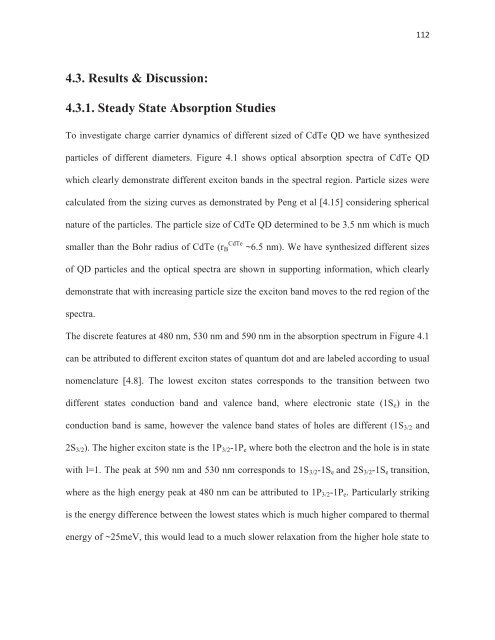CHEM01200604009 Sreejith Kaniyankandy - Homi Bhabha ...
CHEM01200604009 Sreejith Kaniyankandy - Homi Bhabha ...
CHEM01200604009 Sreejith Kaniyankandy - Homi Bhabha ...
You also want an ePaper? Increase the reach of your titles
YUMPU automatically turns print PDFs into web optimized ePapers that Google loves.
112<br />
4.3. Results & Discussion:<br />
4.3.1. Steady State Absorption Studies<br />
To investigate charge carrier dynamics of different sized of CdTe QD we have synthesized<br />
particles of different diameters. Figure 4.1 shows optical absorption spectra of CdTe QD<br />
which clearly demonstrate different exciton bands in the spectral region. Particle sizes were<br />
calculated from the sizing curves as demonstrated by Peng et al [4.15] considering spherical<br />
nature of the particles. The particle size of CdTe QD determined to be 3.5 nm which is much<br />
smaller than the Bohr radius of CdTe (r CdTe B ~6.5 nm). We have synthesized different sizes<br />
of QD particles and the optical spectra are shown in supporting information, which clearly<br />
demonstrate that with increasing particle size the exciton band moves to the red region of the<br />
spectra.<br />
The discrete features at 480 nm, 530 nm and 590 nm in the absorption spectrum in Figure 4.1<br />
can be attributed to different exciton states of quantum dot and are labeled according to usual<br />
nomenclature [4.8]. The lowest exciton states corresponds to the transition between two<br />
different states conduction band and valence band, where electronic state (1S e ) in the<br />
conduction band is same, however the valence band states of holes are different (1S 3/2 and<br />
2S 3/2 ). The higher exciton state is the 1P 3/2 -1P e where both the electron and the hole is in state<br />
with l=1. The peak at 590 nm and 530 nm corresponds to 1S 3/2 -1S e and 2S 3/2 -1S e transition,<br />
where as the high energy peak at 480 nm can be attributed to 1P 3/2 -1P e . Particularly striking<br />
is the energy difference between the lowest states which is much higher compared to thermal<br />
energy of ~25meV, this would lead to a much slower relaxation from the higher hole state to
















